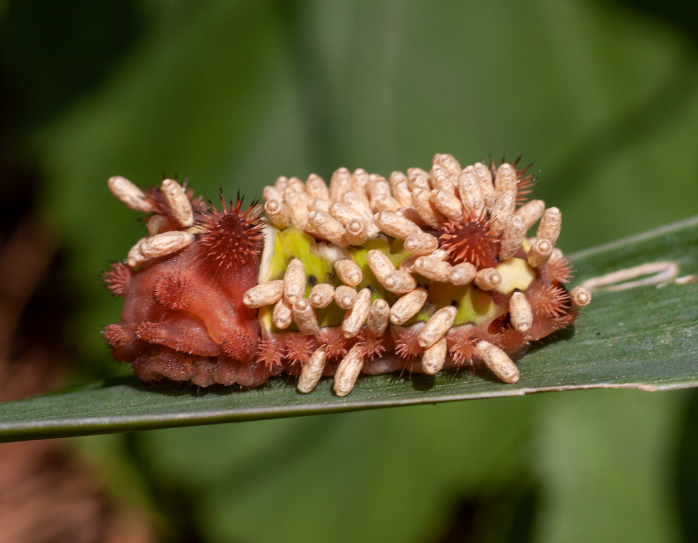A white sheet strung up between two trees in Bartram’s Garden glowed blue in the dark August night. It was speckled with hundreds of insects, ranging in size from tiny wasps and midges, whose identity could only be discerned with a magnifying glass, to geometer moths an inch-and-a-half across.
A small crowd of children and adults pointed and leaned in closer to look, highlighting interesting critters with flashlight beams. LJ Brubaker, the garden’s communications manager, slipped around the craning necks and pointing fingers to call out newly-arrived bugs and answer questions from the human visitors.

More than 50 people had registered for the “Moth Night” at Bartram’s Garden. A parade and “glow party” earlier in the evening had drawn 600 people, and many of the moth watchers at the sheet sported face paint and glow rings.
Bartram’s Garden has been hosting moth nights for at least four years, according to its lead gardener Mandy Katz. In addition to setting up the sheet, Katz painted trees with a homemade mix of molasses, brown sugar, banana, and Hamm’s Beer to attract moths looking for a meal. Ken Frank, local naturalist and author of The Ecology of Center City Philadelphia, set up another sheet and blacklight downhill from the first.
Katz, Frank and Brubaker identified some of the moths with the help of a guidebook. An inch-long, fuzzy, orange moth called a white-pointed prominent hung out toward the bottom of the sheet.
A few dogbane tiger moths, white with orange on their heads and the leading edges of their wings, sat for a while surrounded by midges. A small “bird dropping” moth looked exactly like what its name implied.
However, many of the moths could only be identified to the family level before they flew away. The humans faced the same challenges with other insects at the sheet and the bait stations, such as click beetles (family Elateridae), and caddisflies (order Trichoptera).
If it seems odd that insect enthusiasts encountered species that they couldn’t identify, consider that there are more than 2,100 moth species documented in Pennsylvania. (Butterfly enthusiasts have a much easier time with around 160.) Factor in all the thousands of other flying insect species that could be attracted to a light at night, and a moth night serves as a humbling introduction to the mind boggling diversity of insects, even in an urban park.
Bartram’s Garden isn’t the only place hosting such get togethers.
The Woodlands hosted its Bat and Moth Nature Night in mid-August, partnering with the Academy of Natural Sciences and Temple’s Sewall Lab, according to Emma Max, The Woodlands’ program and operations manager. The event “focuses on bats and moths because they are an important part of our cemetery environment and our urban ecosystem,” Max says.
You can also observe moths on your own schedule.
“Finding moths can be as simple as leaving a porch light on and checking it after dark,” according to the website of National Moth Week (July 20-28, 2019). Adding a sheet gives moths an easily observable place to land, and a blacklight can bring in moths attracted to ultraviolet light.
Professional researchers use similar techniques. Stephen C. Mason, Jr. a PhD candidate and graduate research associate at the Academy of Natural Sciences of Drexel University, uses light traps in the New Jersey Pine Barrens to study how insect populations respond to forest fires.
For the best results, according to Mason, find the darkest location you can on a moonless night to avoid light competition. Although no one is sure why lights draw nocturnal insects, the leading hypothesis, according to Mason, is that artificial light imitates the moon, which moths and many other insects use to help orient themselves.
Our bug neighbors need our help. As researchers have documented, fewer and fewer insects are sharing our nights with us. A study in Germany found that in protected areas flying insect biomass, the total weight of all insects, had decreased by more than 75% in 27 years.
To start, we can ditch bug zappers (which kill mostly harmless bugs and very few of the targeted mosquitoes) and garden insecticides, and fill our gardens with native plants that host native insects. And, of course, events like moth nights can help muster sympathy for otherwise ignored or reviled critters.
“Moths are part of life we don’t really pay attention to,” says Ruben Alexis, who hung around for Bartram’s moth night after initially coming for the glow party. “But here, we put them on display on a canvas.”





